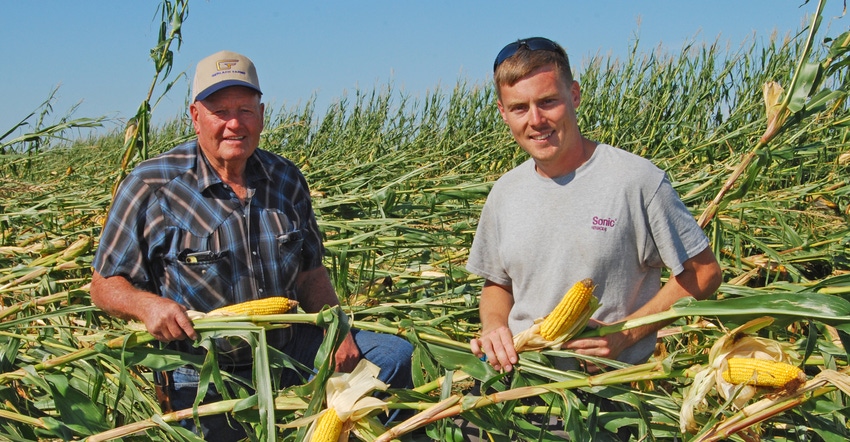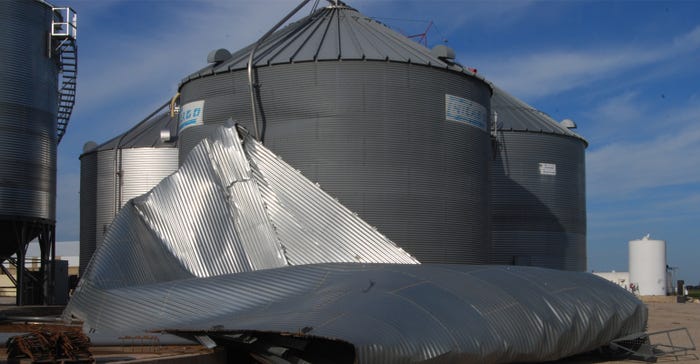August 25, 2020

Forty-years ago this fall, the Gerlach family co-hosted the 1980 Farm Progress Show on their farm near Nevada in central Iowa. Dwayne Gerlach has fond memories. In 2020, another memorable event took place — the Aug. 10 derecho windstorm struck the Gerlach farm and many others across a wide area of Iowa.
“We’re still a family farm, working together as we did 40 years ago,” Dwayne says. “That will help us pull through this unfortunate storm that has devastated millions of acres of crops and damaged a lot of farmsteads in 2020.”
Across about a third of Iowa, farms incurred damage from hurricane-force wind. Gerlach Farms had some grain bins destroyed — one blown down and another blown a half mile across a soybean field. An older barn was destroyed. Homes and other buildings were damaged. Cornfields were knocked down. Stalks were tangled. Harvest will be slow and difficult, trying to lift flattened stalks with the corn head to get ears into the combine.
The Gerlachs will use a special pickup reel mounted on the corn head on two combines. “We’ll try to get all the corn we can,” says Dwayne, who has experience harvesting lodged corn in his many years farming. “If we can get the snouts under the downed stalks and raise the plants up and into the header, we can get most of the corn. It depends on the weather. If the mat of stalks is dry, it will work. But if it’s a wet fall, it’s extra hard to get downed stalks into the combine. They bunch up when it’s wet.”
Picking up lodged corn
Farmers will try various approaches to get the crop out of the field and into the bin. Some will use special corn head attachments. Others will use a regular grain platform, such as for harvesting soybeans, to try to pick up downed corn. “We don’t really know what will work this fall; it depends on the harvesting conditions,” Dwayne says.
 BLOWN DOWN: Two grain bins were destroyed, and the roof damaged on another bin by severe winds on the Gerlach farm.
BLOWN DOWN: Two grain bins were destroyed, and the roof damaged on another bin by severe winds on the Gerlach farm.

Soybeans fared better than corn after the derecho. “The soybean plants stood back up,” says Seth Gerlach, Dwayne’s grandnephew. “There is leaf damage in some fields in the area, as the windstorm brought hail with it in some locations. We are fortunate. Our fields didn’t get much hail. And as dry as this growing season has been, corn is maturing and drying down in the field faster.”
If the weather turns wet, there’s another concern. Downed corn runs an increased risk of fungus developing and creating mold on the ears, which can produce mycotoxins such as aflatoxin. “Corn kernels may even start germinating under the shucks on ears if corn stays wet enough and weather conditions favor it,” Dwayne says. “There are corn quality concerns to watch for with downed corn.”
Crop insurance communication
Working closely with your crop insurance agent and adjuster is good advice. “We are in touch and keeping good records of our fields and production,” Seth says. “Insurance agents and adjusters are very busy these days.”
The Gerlachs notified their agent right away and reported crop damage. The agent asked the Gerlachs to wait two weeks or so before an adjuster came out to view their fields. “They wanted to see how our corn was recovering two weeks after the derecho event,” Seth says. “I’m surprised to see how the corn plants in some fields have been recovering and standing straighter. But there’s still a lot of downed corn, severely lodged as well as broken stalks and dead corn plants in fields.”
With hundreds of on-farm bins destroyed, farmers are looking at alternative grain storage. “We plan to use big plastic grain bags to store corn that won’t fit in our bins,” Dwayne says. “Some farmers are cleaning out machine sheds for temporary storage of dry corn. We are lucky our grain dryer didn’t get damaged or that more of our bins weren’t blown down.”
On Aug. 10 when the derecho struck at around 11 a.m., Dwayne was driving a truck home from another farm where he had been hauling rock for a driveway. He drove on the county road until being blocked by a big tree that had snapped off and was on the road. He stayed in the cab as the storm lasted about 25 minutes.
“I sat there in that blinding storm with an empty tandem truck as the wind lifted the dump bed up and down slightly,” he recalls. “When the storm was over, I drove home. I was fortunate and am thankful.”
More information
If you decide to proceed with harvesting a derecho-damaged cornfield for grain, operational changes may increase the performance and productivity of the combine. Iowa State University specialists have suggestions in the article Combine Adjustments for Harvesting Lodged Corn.
About the Author(s)
You May Also Like






